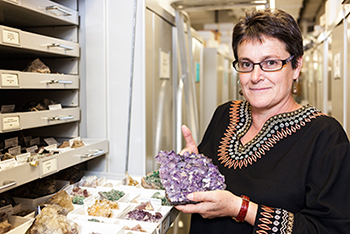AXT Successful with Bid to Supply University of South Australia with A Rigaku Micro Diffractometer
AXT Pty. Ltd., a leading Australian supplier of scientific instruments is pleased to announce that they have won the bid to supply the Mawson Institute at the University of South Australia with a Rigaku D/Max Rapid II Dual Wavelength Micro X-Ray Diffractometer. This system will be the most advanced lab-based micro diffractometer in the country when delivered in October.

Prof. Andrea Gerson holding a specimen of the mineral fluorite (CaF2) originally from Elmwood, Tennessee. This is one mineral sample from the extensive mineral collection held at the South Australian Museum. (Image Credit; Andrew Beveridge).
As a micro diffractometer, the system offers a number of features and capabilities over and above standard powder diffractometers. In particular, the high intensity MM007 DW Microfocus Rotating Anode of the Rapid II offers class leading resolution with the ability to perform XRD on areas as small as 10µm and carry out spatially resolved analyses and X-Y mapping thanks to the high-precision stage. This allows the detection and identification of minor but crucially present phases, small particles, inclusions or impurities.
Rigaku pioneered rotating anode technology. In todays’ context, the ability to automatically switch radiation sources between copper and cobalt generates optimised results and analysis overcoming phenomena such as fluorescence that can occur when analysing iron-based samples with copper radiation. The rotating anode works in harmony with the Rapid II 2D Area Image Plate Detector that features no electronic noise or background as well as a wide dynamic range that is equally sensitive to all wavelengths to produce results of the highest quality.
Unlike other diffractometers, entire components can be examined, without the need to turn the sample into a powder, making it a form of non-destructive testing. This makes it ideal for examining such things as PCBs, welds and bonds.
When asked why the Mawson Institute was attracted to the Rapid II diffractometer, Professor Andrea Gerson, one of the key personnel responsible for the selection explained, “One of the main reasons we chose the Rigaku Rapid II was the flexibility and versatility of the system. We have in fact ordered the system configured to be able to carry out non-ambient transmission studies, stress and texture analyses as well as general bulk powder measurements. I also spoke to a number of other Rigaku users around the world who assured me that the Rapid II would meet our performance expectations.”
This facility will be of particular importance to mineral science. Some of the projects already lining up for analytical time on the Rigaku Micro Diffractometer include the examination of secondary mineralisation formation during acid mine drainage, formation of surface layers during copper ore hydrometallurgical processing, analyses for trace value minerals e.g. uranium containing minerals and for trace toxic minerals e.g. selenium containing minerals and scale formation during alumina Bayer processing, etc.
The Rapid II will help the Mawson Institute stay at the cutting edge of minerals and materials research and extends existing capabilities including X-ray photoelectron spectroscopy, transmission electron microscopy and confocal microscopy. It will also aid their commercial collaborators by accelerating product development and integration of new technologies into next generation manufacturing. Furthermore, the system’s capabilities can be expanded in the future to cater for the analysis of small molecules, thin films, macromolecules including proteins etc., which extends its value into the field life sciences.
The Mawson Institute was able to purchase the Rigaku Rapid II system thanks to funding from the University of South Australia, Adelaide University and the ARC Linkage Infrastructure, Equipment and Facilities Scheme.
For more details about the Rigaku Rapid II, or to find out how it can benefit you, please contact AXT.
Posted June 5, 2014
